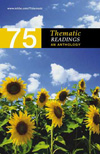
Zora Neale Hurston |  |
Zora Neale HurstonZora Neale Hurston, "How It Feels to Be Colored Me" Zora Neale Hurston (1891?-1960),novelist, short story writer,
journalist, and folklorist, was born in Eatonville, Florida. She attended
Howard University and earned a B.A. from Barnard College in 1928. Hurston's
writing is frank and original and tends to focus on the lives of Southern
blacks. Her books include the folklore collection Mules and Men
(1935) and the novel Their Eyes Were Watching God (1937). Hurston's
career went into eclipse in the 1940s, in part because of her conflict
with eminent black literary figures, in part because of charges (apparently
baseless) that she had molested a child. When she died, she had been working
as a maid. In the early 1970s her reputation and her work were revived,
in large part through the efforts of the writer Alice Walker. "How
It Feels to Be Colored Me" first appeared in 1928 in Negro Digest
and was collected in a book of the same name that same year. | QUESTIONS FOR DISCUSSION | CONTENT - How does Hurston characterize the town where she was born?
- What is the author driving at by suggesting that she wasn't related
to "an Indian chief"?
- Describe the differences between the Northerners and the Southerners
that Hurston points out.
- How does Hurston's life change when she turns thirteen?
- In what ways do the author and her white friend react differently
to the music at the New World Cabaret.
- How does Hurston feel when she's discriminated against?
- Describe the author's perspective of contrast between black and white
approaches to achieving things in life.
STRATEGY AND STYLE - The syntax in the title is unusual. How can you relate the order
and choice of the words there to the author's feeling about her racial
identity?
- "How It Feels to Be Colored Me" is a narration about a part
of one specific woman's life, but it has widespread significance. What
are some of the ways Hurston makes this more than just the story of
a single individual? Where in the essay did you go to support your answer?
- In paragraph ten, the author uses a metaphor to compare herself to
an inanimate object. What is the comparison? What mental image does
it evoke? How can you relate the use of this literary device to her
feelings about being black?
- Study paragraphs eleven, twelve, and thirteen. What content do they
provide? Examine their rhythm: one very long paragraph followed by two
very short ones. How can you tie in this choice to the author's feelings
about the differences between blacks and whites?
| ENGAGING THE TEXT | - Recall a time someone made an assumption about you based upon the
color of your skin. How did it make you feel? What did you do about
it? How can you relate these feelings and actions to your reading?
- Imagine changing races. Which race did you pick? Why? What imaginary
effect did the switch have on your self-identity? Can you link these
thoughts with your reading? If so, how? If not, why not?
| SUGGESTIONS FOR SUSTAINED WRITING | - Hurston writes, "Slavery is sixty years in the past." (Remember,
"How It Feels to Be Colored Me" was written in 1928.) Is she
dismissing slavery merely because it's a historical event? Explain.
How relevant is slavery today?
- Write an essay about the use of color imagery in this piece. Support
your main points with specific evidence from your reading.
| FOR FURTHER RESEARCH | Look through your text and pick either Richard Rodriguez's
"Aria" or Mike Rose's "I Just Wanna Be Average" to
read or reread. Then, write a comparison/contrast paper about it and your
reading here. Do enough research to be comfortable contrasting the relevant
historical periods. | WEB CONNECTION | To put Hurston into a historical context you have to become familiar
with the history of Harlem. Here is a site
with photos depicting Harlem in the first half of the last century. It's
a good place to start your historical journey. | LINKS | Biographical This is a good start page
from Voices From the Gaps. It contains an excerpt from Their
Eyes Were Watching God, a biography, photos, bibliographies, and
links. Here's another start page
from PAL. There, you'll find a photo of Hurston, three bibliographies,
and some study questions. If you had to choose this site or the one
above to use in a paper about Hurston, which one would you pick and
why?
Bibliographical Want to read more by Hurston? Here's Hurston's story "Black
Death" in etext for you. This is an exhaustive collection of links
centering on Hurston's Their Eyes Were Watching God from the
Kingwood College Library in Texas.
Cultural Did you know that Hurston has a festival named in her honor? Here
is the homepage of the
Zora Neale Hurston Festival of the Arts and Humanities, an annual event
that takes place in her hometown. There's also a foundation named after Hurston and Richard Wright
with the mission to build "the world community of writers of African
descent." Learn more about it by clicking here. Read this transcript
of a conversation several college teachers had about Their Eyes Were
Watching God. What kinds of things did you learn about the book
from this transcript? For what information would you have to consult
the book directly?
|
|
|
|